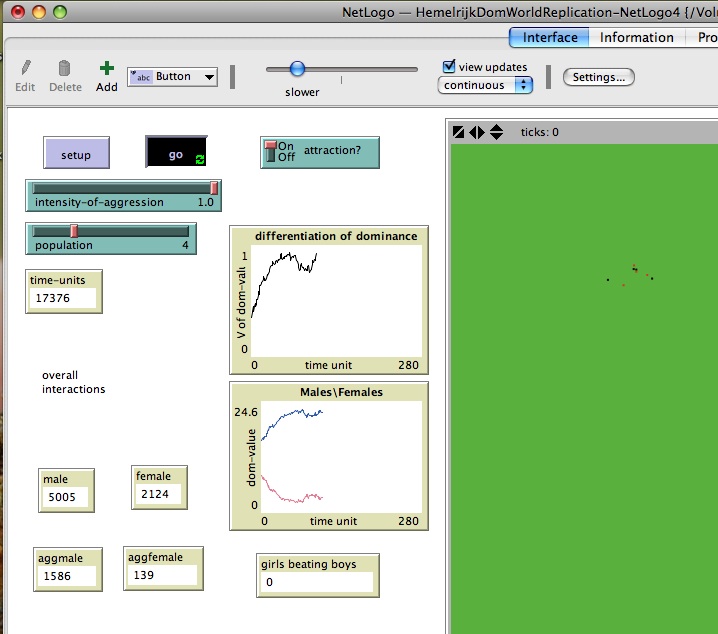Analysis and Replication of
Hemelrijk's DomWorld
This page provides more information about the system we analysed in
our paper:
Which in 2011 was updated as a book chapter:
It includes code so you can check our
replication and watch it run yourself, and a scientific critique of
Hemelrijk's theories of social structure and primate
dominance. Briefly, the DomWorld results all hinge on two
assumptions:
- that there is always at least some chance that any animal in a
hierarchy might beat any other animal in a dominance
interaction.
- that ranks in the dominance hierarchy change frequently as a
consequence of unexpected outcomes from these interactions
(low-ranking animals beating high-ranking ones).
Neither of these conditions holds for many if not most varieties of
social primates.

Charlotte Hemelrijk's DomWorld (which she inherited from her
supervisor Paulien Hogeweg)
is one of the most widely published agent-based models in
biology. Although Hogeweg developed it as part of her research
into bee colonies, Hemelrijk has used it to explain dominance
interactions and social structure in a variety of species, primarily
primates.
Because we were interested in studying primate social structure as
well, and because a number of the primatologists we worked with had
theories that contradicted the DomWorld model, we decided to analyze
it. We first had to replicate the model, partly because there
was no publicly-available version, but also because this is good
scientific practice.
Several MSc and undergraduate students at Bath tried to replicate
DomWorld from Hemelrijk's papers, but none got quite the same
behavior she reported. Finally a PhD student, Hagen Lehmann, found the
missing piece. He fixed the best replication we had so far (by
Jing Jing Andrea Wang), and we presented the paper at two
workshops, and published a paper in a workshop proceedings.
In that paper, we identified six questions that would test the
validity of Hemelrijk's use of DomWorld to describe primate social
behaviour.
After the workshop, we were able to visit the laboratory of Bernard
Thierry, who helped us answer the questions. We found
several problems with the model. The most significant is
that DomWorld predicts that primates' dominance rank should be in
a constant rate of flux. However, in most primate species, a
female's rank is determined entirely by her mother's rank and her
birth order relative to her sisters. On very rare occasions an
entire matrilinial line will change order, but this is really an
exceptional event. This may be a better model of the few species
like chimpanzees where females migrate between social groups, but
for macaques (a widely-used model genus for studying primate
social order) it is not realistic. In egalitarian macaque
species, even changes in male rank happen very infrequently,
mostly in response to the aging or migration of males.
On the other hand, we also found that even if these problems were
removed from the model, some of the other characteristics (such as
its explanation for the spatial location of dominant animals
within the troop) still hold.
Code
One problem with code is that the computer systems on which we run
it keep changing. Thus the actual code we ran for the results shown
in our paper is harder to run now unless you dig up the original
research platforms.
Current Code
Here is newer code for easier replications.
- Amazingly, I am teaching with this code again in 2020. I've
just made two more versions, but I haven't revalidated them
- Due to frequent requests, we have also updated the
Lehmann/Wang code for the current version of NetLogo. Our
replication of Hemelrijk's DomWorld for NetLogo 4.
Save this file & run it in the current version of NetLogo. We
have not run full statistics on this version of the program, but
it seems to run similarly to the archival version. This version
was checked and slightly corrected by Ellen
Evers (November 2008).
- Ando Yasushi has also made a newer version of
his DomWorld replication, although it still doesn't run in
the most recent version of Squeak. You can though use Squeak 3.8, pick the
version for your OS. There are also now simpler instructions for running it,
which are included with the new version.
Archival Code
Here is the exact code we used for the PTRS-B article.
- Hagen Lehmann and Jing Jing Wang's replication of Hemelrijk's
DomWorld code. To run that program, you should
download version 2.2pre2 of NetLogo,
although it may also work in version 3 (but certainly not 4).
- Yasushi Ando's Predation
Simulation includes a second replication of Hemelrijk's
DomWorld. The simulator is written in SmallTalk and must
be executed from within Squeak
version 3.7, which is available
here.
Related Work
page author: Joanna
Bryson
Page last updated 14 December 2008
"Current" Code updated 4 October 2020 for Netlogo 6.1 and
5.3; 6 March 2011 for NetLogo 4.1.1

